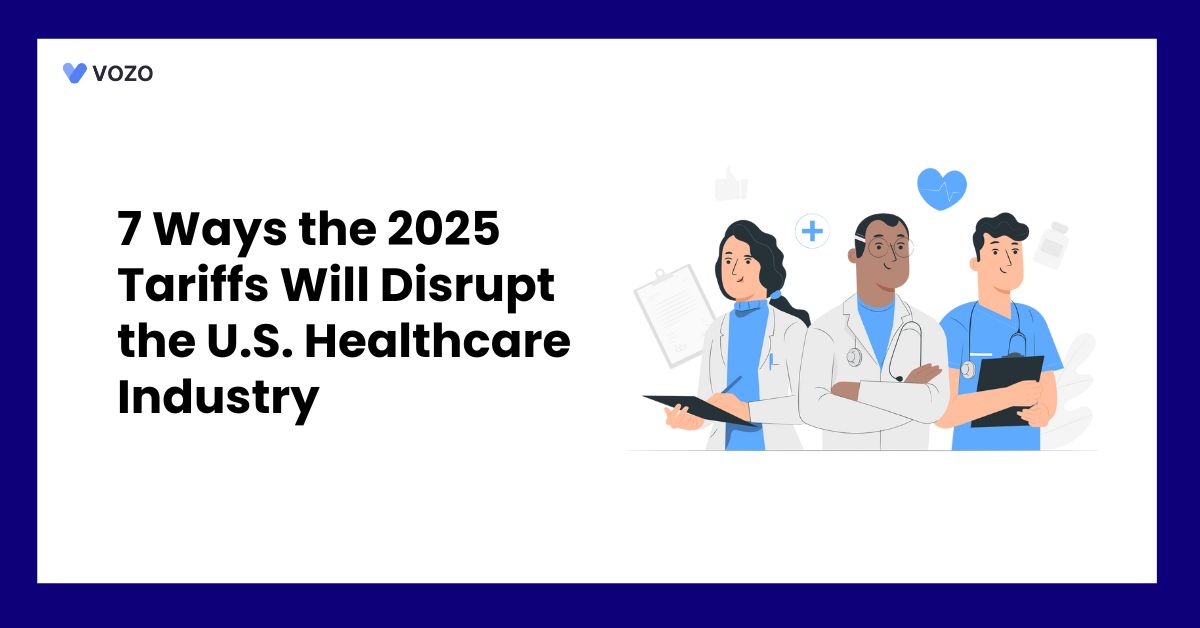7 Ways the 2025 Tariffs Will Disrupt the U.S. Healthcare Industry
The new tariffs announced in April 2025 impose a 10% baseline import tax on most goods (with higher rates for certain countries), and hefty duties on key trading partners. These levies target everything from medical equipment and electronics to network hardware and cloud infrastructure.
The effects are broad in healthcare, where many devices and IT systems rely on global supply chains. HealthTech and HealthIT from these tariffs, with data and industry insight on costs, supply chains, and impacts on hospitals, providers, developers, and patients. Below are seven major disruptions experts expect in the U.S.
How the 2025 Tariff Disrupts the U.S. Healthcare
1. Spiking Costs for Medical Devices and Supplies
Hospitals and clinics already buy most of their devices and supplies abroad, so tariffs will raise prices on everything from syringes to MRI machines. For example, one analyst notes that medical instruments and equipment such as catheters, diagnostic tools, and personal protective equipment could see higher prices due to import taxes.
A recent industry survey found that 88% of healthcare executives expect a spike of 18% or more in equipment costs by late 2025, with 94% predicting even larger jumps (33 %+) for devices tied to China/EU supply chains.
Hospitals and health systems say they have little choice but to absorb or pass these costs on. 90% of hospital finance leaders say they will shift higher expenses to insurers or patients through increased charges. Providers warn that these tariffs “will test healthcare’s fragile supply chain” and could force cuts to services or delays in adopting new technology when margins are already thin.
- Hospital Budgets: Operating margins in healthcare average only 3–4%. Fitch Ratings notes that with fixed reimbursements, hospitals “will see operating income levels drop” if supply costs rise,. Many systems say they will have to delay new equipment purchases or building projects to compensate.
- Patient Costs: As providers face higher import costs, most plan to pass those costs along. In a Black Book survey, nearly all executives said patients or insurers will face higher bills under new tariffs.
- Manufacturer Impact: Device makers like Johnson & Johnson already project hundreds of millions in “tariff headwinds” in 2025, and industry groups warn tariffs could “increase healthcare costs” and hurt innovation.
2. Semiconductor & Electronics Shortages
Many modern health devices and IT systems depend on advanced electronics. Over half of all medical devices rely on semiconductors or chips to function.
Yet the U.S. tariffs include steep duties on electronic imports (34% on China, 32% on Taiwan, 25% on South Korea, plus 10% on all others).
Data-center equipment, servers, networking gear, and even PCs – used in hospitals for imaging, EHRs, and telehealth – are caught in these taxes. In 2024, electronics (including data-center machines) were the second-largest U.S. import at ~$486 billion.
Prices are already rising: after the tariff announcement, laptop, server, and networking equipment costs jumped almost overnight in April 2025. Chip shortages ripple quickly into healthcare: Even though semiconductors were initially exempt, targeted chip levies are expected soon.
One analyst predicts medical device makers “can expect an increase in cost when sourcing semiconductors and chipsets,” and that those costs will be passed to the healthcare system.
Hospitals upgrading their IT or data centers may see budgets swell. In response, some hospitals and tech firms are re-evaluating IT projects: nearly all (94%) of surveyed providers say they are delaying IT modernization and clinical technology upgrades until tariff volatility subsides.
3. Strained Health IT and Data Infrastructure
The tariffs extend beyond devices to the backbone of health IT. Imported data-center equipment, networking switches, storage arrays, and telecom hardware now carry higher taxes. A Reuters analysis notes that Big Tech’s AI and cloud investments may be “hamstrung” by these duties.
In healthcare, this means higher costs for server rooms, routers, and even diagnostic machines that rely on on-premise hardware. Many institutions report that large IT projects (like replacing servers or networking upgrades) are being postponed due to budget uncertainty.
Because software and cloud services (digitally delivered) aren’t taxed, hospitals may pivot to cloud solutions where possible. In practice, providers might delay on-premise IT upgrades and lean more on remote/cloud platforms to avoid expensive hardware. At the same time, any delay in equipment upgrades can raise compliance and security risks if old systems stay online too long. Key Impact:
- Hospitals, labs, and telehealth companies may see longer project timelines and higher infrastructure bills.
- Network and storage upgrades could be scaled back or spread over more years.
- Healthcare IT managers are cautioned to plan extra lead time and budgets as hardware backorders grow.
4. Global Supply Chain Disruptions
HealthTech products use parts from all over the world, so these broad tariffs force companies to scramble. Many device makers are already planning to shift production to “lower-tariff” countries.
For example, PwC and BCG consultants report that U.S. medtech firms are exploring reshoring or near-shoring to avoid new duties. But building new plants or qualifying in other countries takes time. In the interim, supply delays and shortages of critical components are expected.
A survey found procurement timelines slipping within weeks of tariff announcements, with backlogs in surgical kits and imaging parts already reported. Hospitals could face material bottlenecks: Fitch Ratings warns that tariffs will drive up the cost of raw materials like steel and aluminum, which are crucial for the construction and renovation of health facilities.
Even simple supplies (bags, tubing, testing kits) rely on plastics and metals that are now more expensive. With cargo ships and ports potentially disrupted by trade tensions, lead times for imported goods are extending. One healthcare executive notes that providers are forming task forces and stockpiling where possible, but “the updated tariffs… are a full-blown disruption with immediate consequences”.
- Medical Device Makers: Companies using international suppliers must renegotiate contracts or pay more. Some already predict tariff “headwinds” in the hundreds of millions.
- Hospital Projects: Facility upgrades or new construction may be delayed or downscaled as material costs rise. For instance, one analysis suggests that hospitals will defer big ambulatory projects or build smaller clinics to trim costs.
5. Financial Strain on Hospitals and Clinics
With supply costs surging, hospitals’ fragile finances are under pressure. Healthcare runs on low margins, so even moderate cost spikes can be painful. Fitch Ratings observes that hospitals “won’t have a cushion to absorb significant excess supply costs,” meaning higher expenses directly hit their bottom lines.
Unless reimbursement models change, providers must find savings elsewhere. Indeed, 75% of hospital CFOs are already planning short-term cost shifts to payers and patients in response to these tariffs. Facility managers are warning that they’ll cut expenses in other areas. Some plan to delay or cut technology investments and construction projects; others may reduce staff or freeze hiring.
For example, Providence Health (WA) estimated the tariffs could cost it $10–25 million per year, forcing “difficult choices” between services and new tech. Industry leaders fear that this squeeze could erode care quality over time. One report warns that tariffs “could worsen hospitals’ already shaky finances, as well as compromise their ability to deliver timely, high-quality care”.
- Delayed Upgrades: Many hospitals are freezing EHR upgrades, AI projects, and other innovations to conserve cash. A Black Book survey found 94% of providers are pausing IT modernization because of tariff uncertainties.
- Provider Lobbying: Groups like the American Hospital Association are already asking for tariff exemptions on medical supplies, arguing that these taxes threaten patient care.
6. Challenges for HealthTech Startups and Developers
Early-stage HealthTech and HealthIT companies will feel the pain of higher costs, too. Startups often rely on inexpensive imported parts for devices or reference hardware. With tariffs, their component bills jump, and investment dollars may dry up. Analysts warn that trade uncertainty discourages medtech investment and that smaller firms face “serious scale risk” under these tariffs.
In practice, many startups are expected to shift focus to software solutions or U.S.-made kits to survive the import tax squeeze. On the other hand, some see a glimmer of opportunity: if government incentives accompany tariffs, venture capitalists might funnel more funding into domestic manufacturing or software-centric solutions.
But in the short term, health IT developers will likely spend more time on supply-chain planning and cost-cutting. For example, 45% of surveyed healthcare execs have already convened crisis teams to deal with these economic pressures. Software and cloud companies, while not directly taxed on digital goods, may see slower adoption if their hospital customers tighten budgets.
7. Patient Impact: Access and Affordability
Ultimately, patients may feel the effects through higher costs and delayed access to new technologies. If hospitals and clinics pass tariffs through higher service charges or skip expensive new equipment, patients could see longer wait times or fewer advanced treatment options.
For example, tariffs on diagnostics or monitoring devices might slow deployment of new telehealth tools or wearables, especially in rural clinics with tight budgets. Providers worry that care quality could suffer: as one analyst put it, policymakers must balance “the goal of strengthening domestic supply chains” against the risk of “disruptions to patient care”.
So far, much of the toll is being absorbed by the supply side (hospitals and manufacturers). But surveys suggest that 95% of payers expect double-digit drug and device cost inflation to eventually hit insurance claims, which could translate to higher premiums or out-of-pocket costs for patients.
Particularly vulnerable populations may be hurt most if hospitals curb services. In short, patients may face a two-fold hit: higher out-of-pocket prices on procedures and fewer innovative treatments entering the market.
What Can Stakeholders Do? Hospitals, clinics, device makers, and software firms should start planning now. Possible steps include:
- Supply Planning: Stockpile critical supplies and seek alternate suppliers. Survey data show many providers are shifting to the U.S. or non-tariff countries for supplies.
- Cost Management: Re-evaluate budgets and consider increasing service charges or seeking higher reimbursements. Nearly all hospitals expect to charge insurers/patients more under the new tariff regime.
- Tech Strategy: Prioritize essential IT upgrades and delay or phase in others. With hardware costs up, emphasize software and cloud solutions where possible.
- Advocacy: Engage with industry groups to lobby for exemptions on critical healthcare imports.
- Domestic Resilience: Device companies might accelerate plans to build or expand U.S. manufacturing to avoid tariffs in the future, while health IT firms could explore local hardware vendors.
About the author

With more than 4 years of experience in the dynamic healthcare technology landscape, Sid specializes in crafting compelling content on topics including EHR/EMR, patient portals, healthcare automation, remote patient monitoring, and health information exchange. His expertise lies in translating cutting-edge innovations and intricate topics into engaging narratives that resonate with diverse audiences.













